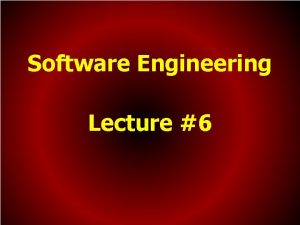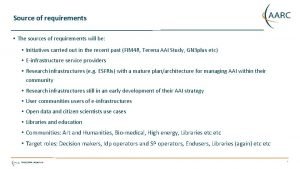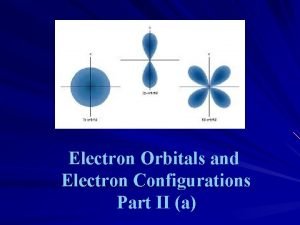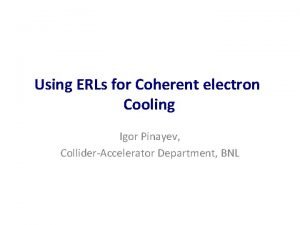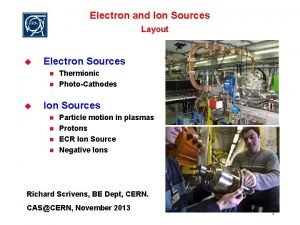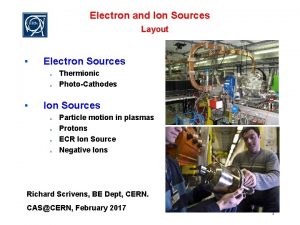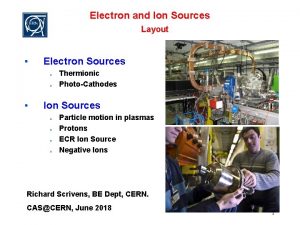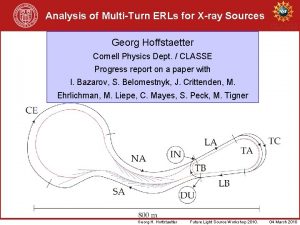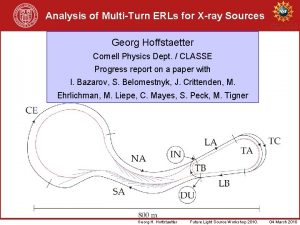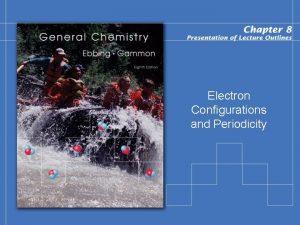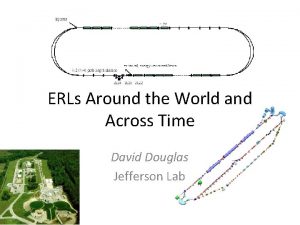Electron Sources for ERLs Requirements and First Ideas











- Slides: 11

Electron Sources for ERLs – Requirements and First Ideas “The workshop is intended to discuss technologies appropriate for a next phase of photon user facilities providing high peak and average photon brightness focusing on the EUV to x ray region, especially CW machines. ” What do ERL class accelerators need from electron sources? What are the limits? Where is overlap? Are there common issues? What direct beam sources are required in the future? Andrew Burrill FLS 2012

What do I consider an Electron Source Injector +for Cathode + Laser an ERL? Andrew Burrill Future Light Sources Workshop March 5 -9 2012

What do ERL class accelerators need from electron sources? What is the purpose of the ERL? o FEL Driver o Storage Ring Replacement (SRR) o R&D Tool or Proof of principle Experiment? Andrew Burrill Future Light Sources Workshop March 5 -9 2012

What is the purpose of the ERL? o FEL Driver or Storage Ring Replacement (SRR) o Must meet user requirements! o Reliability, reproducibility, stability o High Brightness Beams o Short bunch, small transverse size and divergence, small and linear longitudinal emittance. Bn f Andrew Burrill e 0 mc 2 Ecath = 2 p MTE max Future Light Sources Workshop March 5 -9 2012

What is the purpose of the ERL? o R&D Tool or Proof of principle Experiment? o o o Clearly defined deliverables Must deliver meaningful results while meeting schedule and budget constraints! Obligation to push the state of the art o o o Reliability can be relaxed (not a user facility) Great opportunity to investigate entire possible operating regime of the machine Perfect time to collaborate! Andrew Burrill Future Light Sources Workshop March 5 -9 2012

Operational ERLs +1 Gun Cathode Laser λ (nm) Avg Current Charge per bunch Bunch Length Rep Rate Norm Emitt. (mm*mra d) Energy at Gun Exit JLab FEL DC Ga. As 523 10 m. A 135 p. C 3. 4 ps 75 MHz 8 350 ke. V Daresbury DC Ga. As 532 13 u. A 80 p. C 7 ps 81. 25 MHz 1 2 230 ke. V BINP DC Thermionic N. A. 30 m. A 2. 5 n. C 1. 1 ns/ 100 ps 22. 5 MHz 30 300 ke. V HZDR SRF Cs 2 Te 266 1 m. A 77 p. C 4 ps 13 MHz 2 4 Me. V BNL SRF Cs. K 2 Sb 355 50 m. A 5 n. C 70 ps 10 MHz 9. 2 2. 5 Me. V Cornell DC Ga. As/ Cs. K 2 Sb 520 100 m. A (52 m. A) 77 p. C 2 ps 1300 MHz 0. 8 500 ke. V HZB SRF Cs. K 2 Sb 526 100 m. A 77 p. C 2 ps 1300 MHz <1 1. 5 -2 Me. V PKU DC/ SRF Cs 2 Te 266 1 -5 m. A 60 p. C 3 ps 81. 25 MHz 1. 2 3 -5 Me. V JAEA/KEK DC Ga. As 530 100 m. A 77 p. C 20 ps ERLs under Construction (hopefully) Andrew Burrill 1300 1 Future Light Sources Workshop MHz March 5 -9 2012 550 ke. V

Injector / Cathode 0 pportunities to address for FLS Opportunity DC Gun HV Insulator Development X Vacuum condition for high QE cathodes (10 -11 Torr or better) X ? ? X Ion back bombardment mitigation X ? X X Cavity recovery procedure following a “catastrophic event” X X Zero reduction in cavity/cathode performance when cathode is installed X X ? ? Cathode longevity study at >50 m. A for >168 hours Demonstration of 100 m. A sustained operation providing high brightness beam X X X X Andrew Burrill SRF Gun Hybrid (DC/SRF) NCRF Gun X Future Light Sources Workshop March 5 -9 2012

Laser Opportunities • Stability & Reproducibility • Power handling capabilities of components – 100 m. A machines will be punishing • Flexibility – Variable repetition rate ( single shot – CW) – Variable pulse structure – Pulse shaping – spatial, temporal • Beam quality preservation for laser room to gun – Optical transport is critical – Final mirror, especially if located in vacuum, is critical • Reflected light from the cathode must be addressed Andrew Burrill Future Light Sources Workshop March 5 -9 2012

So what are the requirements for an ERL electron source? • • Deliver high brightness beams to users Capable of c. w. operation DC gun or RF gun 700 MHz – 1. 5 GHz Highly flexible (single shot – c. w. ) 10 -100 m. A 77 pc – >1 n. C charge/bunch 100 fs – 20 ps pulse length • It must work all the time! Andrew Burrill Future Light Sources Workshop March 5 -9 2012

What Needs to be clarified Common defintions need to be used when talking about injector performance, irrespective of the choice of gun technology! – Brightness – Emittance (100%, 90%, 0%) – Cathode Lifetime – Maximum sustained current (1 hour, 1 day? ) – Maximum charge extracted Andrew Burrill Future Light Sources Workshop March 5 -9 2012

Final Thoughts Collaborations that are on-going are providing good data that would not necessarily be possible on our own. Injectors can not be designed to operate reliably at the maximum gradient they can achieve in a vertical test! Thank you to the presenters from ERL 2011 for some of the material used in this talk. Andrew Burrill Future Light Sources Workshop March 5 -9 2012
 Print sources and web sources
Print sources and web sources Important of water resources
Important of water resources Source and sink flow
Source and sink flow Sources of requirements
Sources of requirements Ideas have consequences bad ideas have victims
Ideas have consequences bad ideas have victims Los deseos ridículos preguntas y respuestas
Los deseos ridículos preguntas y respuestas Orbital diagonal rule
Orbital diagonal rule Kontinuitetshantering i praktiken
Kontinuitetshantering i praktiken Novell typiska drag
Novell typiska drag Nationell inriktning för artificiell intelligens
Nationell inriktning för artificiell intelligens Vad står k.r.å.k.a.n för
Vad står k.r.å.k.a.n för Varför kallas perioden 1918-1939 för mellankrigstiden?
Varför kallas perioden 1918-1939 för mellankrigstiden?


